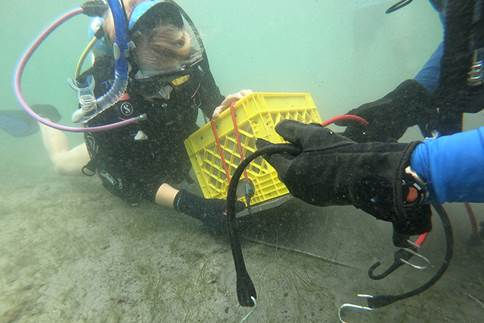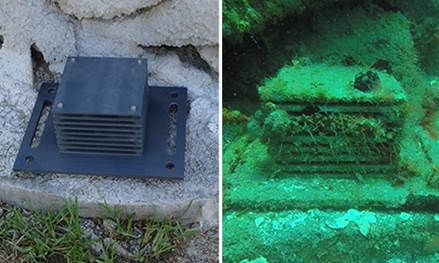Palm Beach State College works with Smithsonian Institution for reef research
- Michelle Morrison
- Sep 20, 2022
- 3 min read

PBSC Professor Jessica Miles, Ph.D., with the help of a volunteer dive team, retrieves an ARMS from Jupiter Inlet. The ARMS were deployed in and just outside the Jupiter Inlet, at depths of 8 feet and 50-60 feet respectively.
Photo by Palm Beach State College.
Palm Beach State College has joined with the Global Autonomous Reef Monitoring Structures (ARMS) Program of the Smithsonian Institution’s National Museum of Natural History to explore the ocean floor.
Palm Beach State College is the first college in South Florida to participate in the program.
The ARMS allow scientists to learn about species and marine communities and provide an overall assessment of an ecosystem. The ARMS, which are 9" by 9" stacks of plates, imitate the natural sea bottom, which is complex in structure and difficult to sample without dismantling natural habitat. They provide hard surfaces and crevices that are enticing to small sea creatures so we can better understand changes in marine biodiversity and improve ocean health.

Before deployment and upon retrieval views of the ARMS, which are like mini-condos for marine life, and once retrieved, scientists can see who moved in.
Photo by Palm Beach State College.
At the forefront of the project in South Florida is Professor Jessica Miles, the chair of Palm Beach State’s environmental science department. She and her team installed monitoring structures in and outside the Jupiter Inlet in 2017 as part of her Reef Hope Project, fueled by her passion to involve students from all academic disciplines in saving the coral reefs.
In August, five years after planting ARMS at the bottom of the ocean, Miles and two dive teams recovered three ARMS. Scientists from the Smithsonian flew down to train Miles and her team on how to examine the new marine life found in the ARMS.
“This was a long-term project, so I was very excited to finally see what had moved into these units,” Miles says. “This is our chance to put Jupiter on the map. There are ARMS all over the world, but this is the first time the deeper waters outside the Jupiter Inlet are being represented.”
Miles says it is groundbreaking for the scientific community to understand the organisms living in this ecosystem and to be able to catalog them, monitor them and track any changes. “Maybe some of these animals will move further north as the climate changes, seeking out cooler waters. This type of study is the least invasive kind of research project we can do to understand what the complexity of species actually are.”
A team of three Smithsonian scientists, Miles and other PBSC faculty and students, and Jupiter Inlet Lighthouse Outstanding Natural Area staff spent three days studying the ARMS. The team found hundreds of species and anticipates finding thousands more in the coming months using DNA metabarcoding techniques.
“It doesn’t get much better than that,” Miles says about the excitement of having her students work alongside the Smithsonian scientists.
Rida Talukdar, who is studying environment science technology and is Miles’ student assistant, says: “Watching them work was a mind-blowing experience. The scientists would always make sure to stop and explain what they were doing, and if we ever had any questions, they would explain everything to us, teaching us all the processes of disassembling the ARMS and how to study the creatures.”
Miles wants to publish the team’s findings and to create a public exhibit that can move among nature centers and college campuses. She wants to share what the ocean has to offer to the community, especially with people who haven’t explored beyond the surface.
“A lot of people experience the ocean, but just on the surface as a blanket of blue water. They don’t get to see what’s going on underneath,” Miles says. “They don’t get to know these characters that are really sustaining the health and vitality of our coastal ecosystem. We get a chance to do that if we scuba dive, but most people do not get to have that kind of opportunity. So this is a way for us to bring all of that information to light.”












Comments